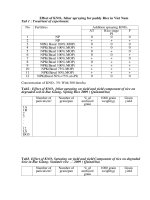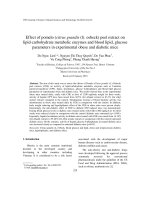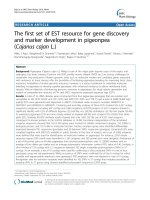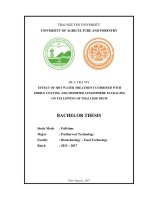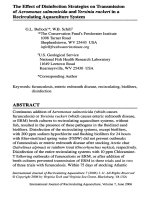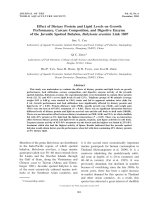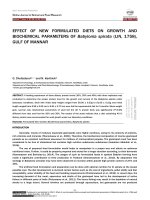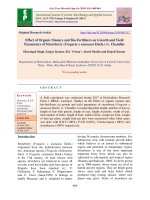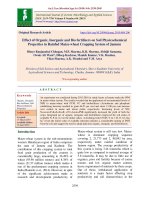Effect of conventional and nano micronutrient fertilizers on yield and economics of pigeonpea [Cajanus cajan (L.) Mill sp.]
Bạn đang xem bản rút gọn của tài liệu. Xem và tải ngay bản đầy đủ của tài liệu tại đây (442.51 KB, 9 trang )
Int.J.Curr.Microbiol.App.Sci (2019) 8(9): 185-193
International Journal of Current Microbiology and Applied Sciences
ISSN: 2319-7706 Volume 8 Number 09 (2019)
Journal homepage:
Original Research Article
/>
Effect of Conventional and Nano Micronutrient Fertilizers on Yield and
Economics of Pigeonpea [Cajanus cajan (L.) Mill sp.]
Kailas1*, H. Veeresh1, K. Narayana Rao1, S.R. Balanagoudar1 and H. Sharanagouda2
1
Department of Soil Science and Agricultural Chemistry, 2Department of Processing and
Food Engineering, University of Agricultural Sciences, Raichur, College of Agriculture,
Raichur – 584 104, India
*Corresponding author
ABSTRACT
Keywords
Pigeonpea, Nano
multi
micronutrients,
Conventional, RDF
Article Info
Accepted:
04 August 2019
Available Online:
10 September 2019
The field experiment was carried out with different grade foliar spray solutions and soil
application of nano and conventional multi micronutrient fertilizers to study their effect on
yield and economics of pigeonpea [Cajanus cajan (L.) Millsp.] during kharif season, 2015
at Main Agriculture Research Station, Raichur. The results revealed that foliar spray of
either conventional or nanomulti micronutrients along with RDF have shown higher grain
yields of pigeonpea when compared with the RDF alone (941.8 kg ha-1). Among
conventional and nano multi micronutrient foliar sprays, the conventional multi
micronutrient mixtures showed comparatively higher yield over the nano. In the case of
soil applications, the applications of nano and conventional sodium molybdate to the soil
have given comparatively higher yields (951.5 and 984.7 kg ha-1) than the RDF alone
(941.8 kg ha-1) but the differences in yields were non-significant. The cost economic
analysis of various treatments has given the highest B:C ratio of 2.32 to the treatment
conventional multi micronutrients along with RDF while B:C ratio was lowest (0.85) for
nano multi micronutrients owing to high input costs of nano micronutrients.
Introduction
Pigeonpea [Cajanus cajan (L.) Millsp.] the
second most important pulse crop of India
after chickpea being cultivated in a multitude
of production systems for a diversity of uses
viz., grain as dhal, green seed as a vegetable
and stalk as fuel wood. Pigeonpea is
commonly known in India as redgram or
arhar or tur. It is grown throughout the
tropical and sub-tropical regions of the world,
between 30o N and 35o S latitudes. However,
major area under pigeonpea in India is lying
between 14o S and 28o N latitudes. Pigeonpea
is predominantly grown in India during kharif
season both as a sole crop and as intercrop,
and found in wide range of agro-ecological
situations. Its deep rooting and drought
tolerating character make it a successful crop
in areas of low and uncertain rainfall.
In India, pigeonpea is grown in an area of 36.3
lakh hectares with a production of 27.6 lakh
tonnes and productivity being 760.33 kg ha-1.
185
Int.J.Curr.Microbiol.App.Sci (2019) 8(9): 185-193
In Karnataka, among the pulses, pigeonpea
stands first in both area and production. The
crop is grown in an area of 6.81 lakh hectares
with a production of 4.85 lakh tonnes and
productivity of 712.19 kg ha-1 (Anon., 2014).
The low productivity of pigeonpea in India
may be attributed to vagaries of climate and
poor soil nutrient management practices more
particularly micronutrients.
Micronutrients play a significant role in plant
growth and metabolic processes associated
with photosynthesis, chlorophyll formation,
cell wall development and respiration, water
absorption, xylem permeability, resistance to
plant diseases, enzyme activities involved in
the synthesis of primary and secondary
metabolites, and nitrogen fixation and
reduction (Adhikary et al., 2010; Vitti et al.,
2014). However, as most of the nutrients are
taken up into the plant in the forms of soluble
inorganic ions by plant root system; therefore,
water stress reduces nutrient absorbability and
nutrient uptake of the plant in drought
situations even when the crop is facilitated
with balanced nutrition through soil
application, a most common scenario that
prevail in rainfed agriculture.
Foliar spraying have advantages of low
application rates, uniform distribution of
fertilizer materials and quick response to
applied nutrients. Although there is still some
speculation about the benefits and correct
implementation of this practice, foliar
application of specific nutrients is considered
a better approach to improve the efficiency of
fertilizer use and increase crop yields.
In recent years the use of nano sized fertilizer
mixtures in agriculture is gaining momentum
to enhance nutrient use efficiency and
overcome the chronic problems associated
with the high use of conventional fertilizers.
Therefore, efforts have been made to assess
the feasibility of nano micronutrient fertilizer
in comparison to the conventional fertilizers
on the yield and economics of pigeonpea.
Materials and Methods
The field experiment was conducted during
kharif, 2015 at MARS farm, Raichur, situated
in the North Eastern Dry Zone (Zone-2) of
Karnataka between 16º15` N latitude and 77º
20` E longitude with an altitude of 389 m
above the mean sea level. The treatment
combinations were laid out in randomized
block design with nine treatments and three
replications. The soil was medium black with
clay texture. It had slightly alkaline pH (8.13)
and low EC (0.23 dS m-1). The CEC of soil
was medium (38.7 c mol(p+)kg-1) while the
soil organic carbon content was low (4.10 g
kg-1).
The soil was low in available nitrogen (139.4
kg ha-1) and high in available phosphorous
(58.62 kg ha-1) and potassium (462.5 kg ha-1).
The concentrations of DTPA extractable
micronutrients viz., iron, manganese and zinc
were 5.35, 7.61 and 0.51mg kg-1respectively.
The hot water soluble boron and ammonium
acetate extractable molybdenum were 0.40
and 0.02 mg kg-1 respectively.
The variety TS-3R used in the study is a short
duration, red and bold seeded variety which
matures in 145 to 150 days. It is resistant to
both wilt and sterility mosaic and it is suitable
for kharif season.
The equivalent quantity of NPK and zinc
sulphate required for each treatment plot was
calculated and applied two days after the
sowing of pigeonpea. The fertilizers were
placed in furrows opened at 5 cm away from
the seed line (crop row) and covered with soil.
Full dose of P and zinc sulphate along with
50%N was applied as basal and the remaining
50% N was placed at 30 days after sowing. All
other cultural and plant protection measures
186
Int.J.Curr.Microbiol.App.Sci (2019) 8(9): 185-193
were followed as recommended. The multi
micronutrient mixture (Grade I) was prepared
as per Karnataka State Department of
Agriculture recommendations i.e., Fe: 2.0%,
Mn: 1.0%, Zn: 3.0 % and B: 0.5%. This
mixture was prepared in the laboratory by
using iron sulfate, manganese sulfate, zinc
sulfateand boric acid.
The nano micronutrients like FeO and ZnO
were procured from Sisco Research
Laboratory Pvt. Ltd., Mumbai, India. The
particle size of the FeO and ZnOwere
observed to be around 87 nm and 134 nm,
respectively (Plate 1). These sizes were
confirmed by analyzing the samples in
Scanning Electron Microscope (Evo-18, Zeiss
Smart, Switzerland). On the other hand, nano
micronutrients of manganese and boron were
prepared from reagent grade MnO2 andBoric
acid by using high-speed cryo ball mill
(Retsch, CryoMill) at Nano Technology
Laboratory, UAS, Raichur. The particle size
of the powdered MnO2 and boric acid were
analyzed by using Zetasizer (Malvern
Zetasizer, Nano-ZS, Malvern Instruments,
UK) at NTL, UAS Raichur and the particle
sizes were found to be around 789 nm for
MnO2 and 10 nm for that of boric acid
particles.
The multi micronutrient mixture of
nanoparticles containing Fe (0.2%),Zn(0.3%),
Mn (0.1%) and B (0.05%) was prepared by
using the respective nanoparticles. The so
prepared mixture solution was preserved by
adding a pinch of citric acid powder with 109
nm size particles.
The foliar application of above prepared
conventional and nano multi micronutrient
mixture solutions in respective treatment plots
were taken at 70 DAS and 100 DAS by using
the above stock solutions @ 10 ml per liter
concentrations.
Treatment details
T1
T2
:
:
T3
:
T4
:
T5
:
T6
:
T7
:
T8
:
T9
:
Note:
100% RDF
T1 + Soil application of conventional sodium
molybdate
T1 + Soil application of nano sodium
molybdate
T1 + Foliar spray of conventional multi
micronutrients
T1 + Foliar spray of nano multi
micronutrients
T2 + Foliar spray of conventional multi
micronutrients
T3 + Foliar spray of conventional multi
micronutrients
T2 + Foliar spray of nano multi
micronutrients
T3 + Foliar spray of nano multi
micronutrients
RDF of pigeonpea: 25:50:0:15 N, P2O5, K2O,
ZnSO4 in kg ha-1
Multi micronutrient mixtures of Grade I as per
KSDA (Fe: 2%, Mn: 1%, Zn: 3%, B: 0.5%) @
10 ml per liter of water;
Soil application of conventional sodium
molybdateis @ 1.5 kg ha-1 while nano sodium
molybdate@ 0.5 kg ha-1
Nano micronutrients are foliar sprayed @10%
of the conventional fertilizer dosesi.e. Fe:0.2%;
Mn:0.1%, Zn: 0.3% & B: 0.05%
All the treatments received FYM @ 6.0 t ha-1 as
common application
Approximately, a spray volume of 500 litres
per ha at 70 DAS and 750 litres per ha at 100
DAS was required to apply uniformly. The
soil application of nano and conventional
sodium molybdate was done@ 0.5 and 1.5 kg
ha-1, respectively. The application was carried
out by mixing the required quantity of
respective
sodium
molybdate
with
approximately 1.0 kg of soil from the
respective treatment plot in a plastic tray and
was applied along the seed line in respective
treatment plots on the day of sowing.
Five tagged plants from the net plot area
which were used for recording growth
parameters were harvested separately at
187
Int.J.Curr.Microbiol.App.Sci (2019) 8(9): 185-193
physiological maturity and were used for
recording various yield components and grain
yield.
treatments of foliar applications of
conventional multi micronutrients over the
nanomulti micronutrients.
Results and Discussion
The improvement in yield is achieved through
improvement in yield attributing characters
like grain yield per plant and test weight of
100 grains. Moreover, the grain yield per plant
is greatly influenced by dry matter
accumulation in reproductive parts like pods.
The highest dry matter production of
reproductive parts was found in the treatment
T4 i.e. 18.50 g plant-1 and 32.29 g plant-1 at
100 DAS and at harvest, respectively when
compared to all other treatment combinations.
The differences in various yield components
which led to significant yield differences
among different multi micronutrients could be
attributed to differences in dry matter
production and its distribution into different
plant parts. The total dry matter per plant was
significantly higher with the application of
RDF along with foliar spray of conventional
multi micronutrients at 100 DAS (99.29 g
plant-1) and at harvest (136.5 g plant-1) and
was followed by RDF with foliar spray of
nano micronutrients at 100 DAS (95.62 g
plant-1) and at harvest (130.7g plant-1) in the
study. The observation on dry matter
accumulation of pigeonpea at 70 DAS has
shown no clear trends and visible differences.
This may be due to fact that the first foliar
spray of either nano or conventional
micronutrients was taken up at 71st day after
sowing and the second was followed at 101st
day after sowing. Therefore, impact of these
foliar sprays could be reflected possibly at 100
DAS and at harvest of crop only.
The present investigation was undertaken to
study the effect of foliar application of
nanoand conventional micronutrients on yield
and economy of pigeonpea cultivation. In
general, the application of RDF along with
either nano or conventional micronutrients
either through soil or foliar spray has resulted
comparatively better yields than the soil
application of RDF alone (948 kg ha-1). In
treatments that are supplemented with foliar
sprays along with RDF, the treatment with
foliar spray of conventional micronutrients
gave higher yielded (1424 kg ha-1) than the
foliar spray of nano multi micronutrients
(1281 kg ha-1). On the other hand, the
treatment with foliar spray of nano multi
micronutrients along with soil application of
conventional sodium molybdate recorded
higher yield (1358 kg ha-1) compared to the
treatment with foliar spray of conventional
micronutrients along with soil application of
either nano or conventional sodium molybdate
(Table 1).
From the study, as a whole it was observed
that the highest grain yield of pigeonpea was
from treatment plots that have received the
RDF and foliar spray of conventional
micronutrient mixture (1424 kg ha-1) which is
significantly higher over all other treatments.
Thus, indicating that foliar spray of
conventional micronutrient mixture is better
than the nano products. However, it should be
noted that the respective concentration of each
of nano micronutrients used in the foliar spray
solutions were lower i.e., one tenth of the
conventional micronutrient concentrations.
Moreover, conventional multi micronutrient
mixtures also carried sulphur along with them,
an important secondary nutrient. These facts
might have given added advantages to the
In the present study, grain yield per plant
(36.61 g) and test weight of 100 grains (13.53
g) were significantly higher in the treatment
which received RDF with foliar spray of
conventional multi micronutrient mixture to
an extent of 29.8 and 25.3 per cent,
respectively over the treatment that had RDF
alone.
188
Int.J.Curr.Microbiol.App.Sci (2019) 8(9): 185-193
Table 1. Average crop yield parameters of pigeonpea as influenced by various treatments
Treatments
Number of
pods plant-1
Number of
grains pod-1
Test weight Grain yield Grain yield Stalk yield Husk yield
(g)
(g plant-1)
(kg ha-1)
(kg ha-1)
(kg ha-1)
T1
136.7
2.13
10.11
25.68
942
2192
922
T2
139.3
2.16
10.31
26.32
952
2491
1143
T3
140.4
2.12
10.65
27.12
985
2310
1115
T4
159.2
2.34
13.53
36.61
1424
3275
1325
T5
156.3
2.40
11.97
31.90
1281
2916
1244
T6
147.1
2.59
12.21
31.35
1264
2677
1239
T7
155.2
2.29
12.16
32.10
1300
2730
1286
T8
157.3
2.46
12.49
35.01
1358
3124
1306
T9
148.5
2.31
11.95
30.24
1192
2612
1204
S.Em±
CD at 5%
3.428
10.29
0.073
NS
0.463
1.391
1.590
4.772
47.69
143.1
183.1
549.5
27.01
81.10
Note : T1 - RDF (25:50:0 NPK kg ha-1 + ZnSO4 @ 15 kg ha-1) ; T2 - T1 + Soil application of sodium molybdate (1.5kg ha -1) ; T3 - T1
+ Soil application of nano sodium molybdate (0.5 kg ha -1) ; T4 - T1 + Foliar spray of multi micronutrients (Fe, Mn, Zn, B) ; T 5 - T1 +
Foliar spray of nano multi micronutrients (Fe, Mn, Zn, B) ; T 6 - T2 + T4 ; T7 - T3 + T4 ; T8 - T2 + T5 ; T9 - T3 + T5
189
Int.J.Curr.Microbiol.App.Sci (2019) 8(9): 185-193
Table.2 Simple correlation coefficients between yield parameters of pigeonpea
Factor
1
2
3
4
5
1. Number of pods plant-1
1
2. Number of grains pod-1
0.64
1
3. Test weight (g)
0.92
0.72
1
4. Grain yield (g plant-1)
0.95
0.70
0.97
1
5. Grain yield (kg ha-1)
0.96
0.77
0.98
0.98
1
6. Stalk yield (kg ha-1)
0.93
0.65
0.91
0.96
0.92
6
1
Table.3 The economic analysis and benefit cost ratio of pigeonpea
Treatment
Cost of
cultivation
(`. ha-1)
Gross
returns
(`. ha-1)
Net
returns
(`. ha-1)
Benefit cost
ratio
T1
31869
51799
19930
1.63
T2
34569
52335
17766
1.51
T3
34667
54161
19494
1.56
T4
33685
78309
44624
2.32
T5
85828
70439
-15390
0.82
T6
34885
69509
34624
1.99
T7
34982
71495
36512
2.04
T8
87028
74697
-12331
0.86
T9
87125
65566
-21560
0.75
S.Em±
-
-
1753
0.04
CD at 5%
-
-
5254
0.13
-1
-1
Note : T1 - RDF (25:50:0 NPK kg ha + ZnSO4 @ 15 kg ha ) ; T2 - T1 + Soil application of sodium molybdate @
1.5kg ha-1; T3 - T1 + Soil application of nano sodium molybdate @ 0.5 kg ha-1 ; T4 - T1 + Foliar spray of multi
micronutrients (Fe, Mn, Zn, B) ; T 5 - T1 + Foliar spray of nano multi micronutrients (Fe, Mn, Zn, B) ; T 6 - T2 + T4 ;
T7 - T3 + T4 ; T8 - T2 + T5 ; T9 - T3 + T5
190
Int.J.Curr.Microbiol.App.Sci (2019) 8(9): 185-193
Plate 1. (a) SEM image of iron oxide (FeO) nanoparticles
Plate 1. (b) SEM image of zinc oxide (ZnO) nanoparticles
191
Int.J.Curr.Microbiol.App.Sci (2019) 8(9): 185-193
The increase in yield can be attributed to the
higher availability of assimilates with foliar
spray of multi micronutrients. Further,
significant differences in the seed yield of
pigeonpea with foliar spray of micronutrients
might be attributed to improved growth and
yield components viz., total dry matter
production and its distribution into different
plant parts, number of branches per plant,
number of pods per plant, seed yield per plant
and test weight of 100 grains. This can be
validated by the observed significant positive
correlations among the above yield
parameters with grain yield in the present
study (Table 2). Similar findings and
observations were also reported by Tekale et
al., (2009); El-Seifi et al., (2013); Mukund et
al., (2013) and Gowthami and Rama
Rao(2014).
observations on growth and yield of
pigeonpea showed no added advantages due
to application of these treatments when
compared to the treatment RDF alone. On the
other hand, a study by Karpagam and Rajesh
(2014) have reported that soil application of
sodium molybdate have given higher yield in
greengram while Singh et al., (2014)
observed improved crop growth and yield in
mungbean with soil application of B and Mo.
The treatment which received RDF with foliar
spray of conventional multi micronutrient
fertilizers recorded significantly higher gross
returns (Rs.78,309), net returns (Rs. 44,624)
and BC ratio (2.32) compared to rest of the
treatments (Table 3). This is due to low input
cost and high crop yield were obtained. On
the other hand, treatments which received
nano multi micronutrients (T9, T8, T5)
application had higher cost of cultivation
(Rs.87125, 87028, 85828 respectively) owing
to high price of nanoparticles micronutrients
and thus the net returns of these treatments
were in negative and BC ratio is less than one
i.e.,
0.75,
0.86,
0.82,
respectively.
Considering the above facts, the use of
conventional multi micronutrients along with
RDF has been found to be more beneficial
than other treatments.
The higher grain yield of pigeonpea due to
foliar spray of multi micronutrient mixtures
can also be supported by the facts that these
treatments have positive effect on growth and
development of pigeonpea which is evidenced
by higher plant height, number of branches,
number of leaves and dry matter
accumulation in leaves over RDF alone.
Similarly, Basharat et al., (2014) have also
observed increase in plant growth parameters
of mungbeen with foliar spray of
micronutrients.
Based on the experimental results, one can
conclude
that
foliar
application
of
conventional multi micronutrients of Grade-I
along with the recommended dose of fertilizer
in pigeonpea at flower initiation and pod
bearing stages can be more beneficial in terms
of higher grain yield and higher net returns
than the foliar application of nano multi
micronutrients and soil application of either
conventional or nano sodium molybdate.
Effect of soil application of both conventional
and nano sodium molybdate were also
assessed during the study. It is known that
molybdenum has a key role in the
development of root nodules and in symbiotic
nitrogen fixation and thus beneficial for crop
growth and development. However, in the
present investigation, we failed to record and
monitor the observations on number of root
nodules, effective root nodules etc. owing to
certain practical difficulties. Complete
uprooting of roots was not practically possible
after 70 DAS onwards. Leaving this aside, the
References
Adhikary, B. H., Shrestha, J. and Baral, B. R.,
2010, Effects of micronutrients on
192
Int.J.Curr.Microbiol.App.Sci (2019) 8(9): 185-193
growth and productivity of maize in
acidic soil. Int. Res. J. Appl. Basic Sci.,
1: 8-15.
Anonymous, 2014, Ministry of Agriculture,
Govt. of India.www.nmoop.gov.in
Basharat Ali., Asghar Ali., Muhammad Tahir.
and Shafaqat Ali., 2014, Growth, seed
yield and quality of Mungbean as
influenced by foliar application of iron
sulfate. Pak. J. life Soc. Sci., 12 (1): 2025.
El-Seifi, S. K., Hassan, M. A. and Al-Saeed,
M. A., 2013, Effect of foliar spray with
some micronutrients on growth, yield
and chemical composition of pigeonpea.
J. Plant Production, 4 (4): 685 – 691.
Gowthami, P. and Rama Rao, G., 2014,
Foliar application potassium, boron and
zinc on growth and yield of soybean.
Int. J. of Food, Agric. and Veterinary
Sci., 4 (3): 81-86.
Karpagam, J. and Rajesh, N., 2014,
Molybdenum application for enhancing
growth and yield of Green gram.
American-Eurasian J. Agric. Environ.
Sci., 14 (12): 1378-1381.
Mukund, G. K., Halepyati, A. S., Koppalkar,
B. G. and Satyanarayana, 2013,
Response of pigeonpea (Cajanuscajan
L.
Millsp.)
to
application
of
micronutrients through soil and foliar
spray of macronutrients on yield,
economics and protein content. Kar. J.
Agric. Sci., 27 (4): 460-463.
Singh, A. K., Khan, M. A. and Arun
Srivastava., 2014, Effect of boron and
molybdenum application on seed yield
of mungbean. Asian J. Bio Sci.,9 (2):
169-172.
Tekale, R. P., Arti, G. and Kavita, A., 2009,
Impact of boron, zinc and IAA on
growth, dry matter accumulation and
sink potential of pigeonpea (Cajanus
cajan L.). Agric. Sci. Digest. 29 (4):
246-249.
Vitti, A., Nuzzaci, M., Scopa, A., Tataranni,
G., Tamburrino, I. and Sofo, A., 2014,
Hormonal
response
and
root
architecture in Arabidopsis thaliana
subjected to heavy metals. Int. J. Pl.
Bio., 5: 5226-5232.
How to cite this article:
Kailas, H. Veeresh, K. Narayana Rao, S.R. Balanagoudar and Sharanagouda, H. 2019. Effect of
Conventional and Nano Micronutrient Fertilizers on Yield and Economics of Pigeonpea
[Cajanus cajan (L.) Mill sp.]. Int.J.Curr.Microbiol.App.Sci. 8(09): 185-193.
doi: />
193
